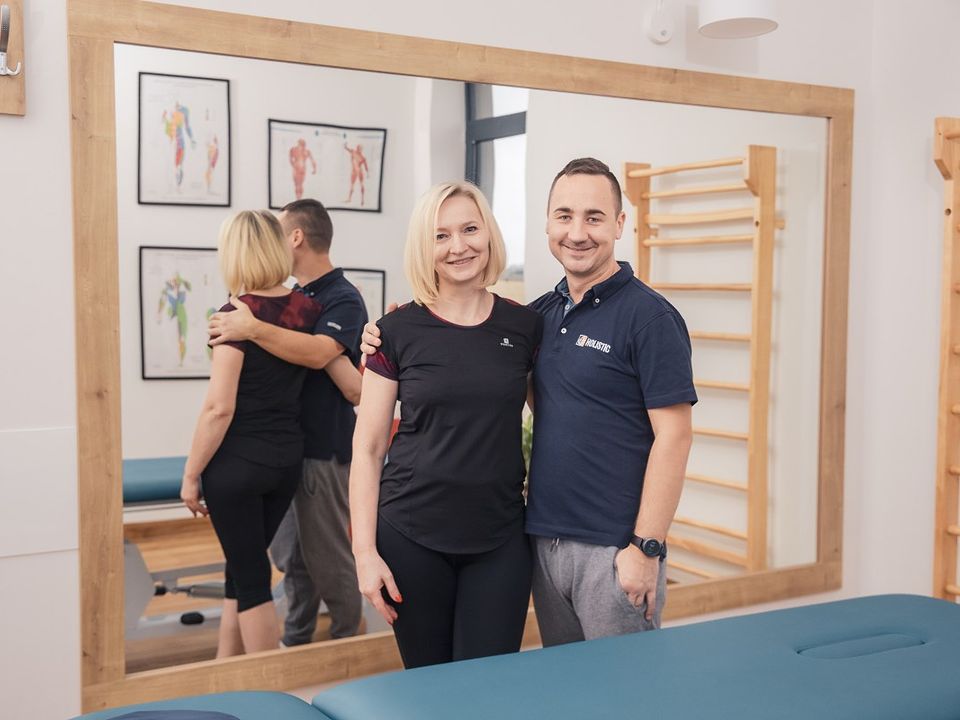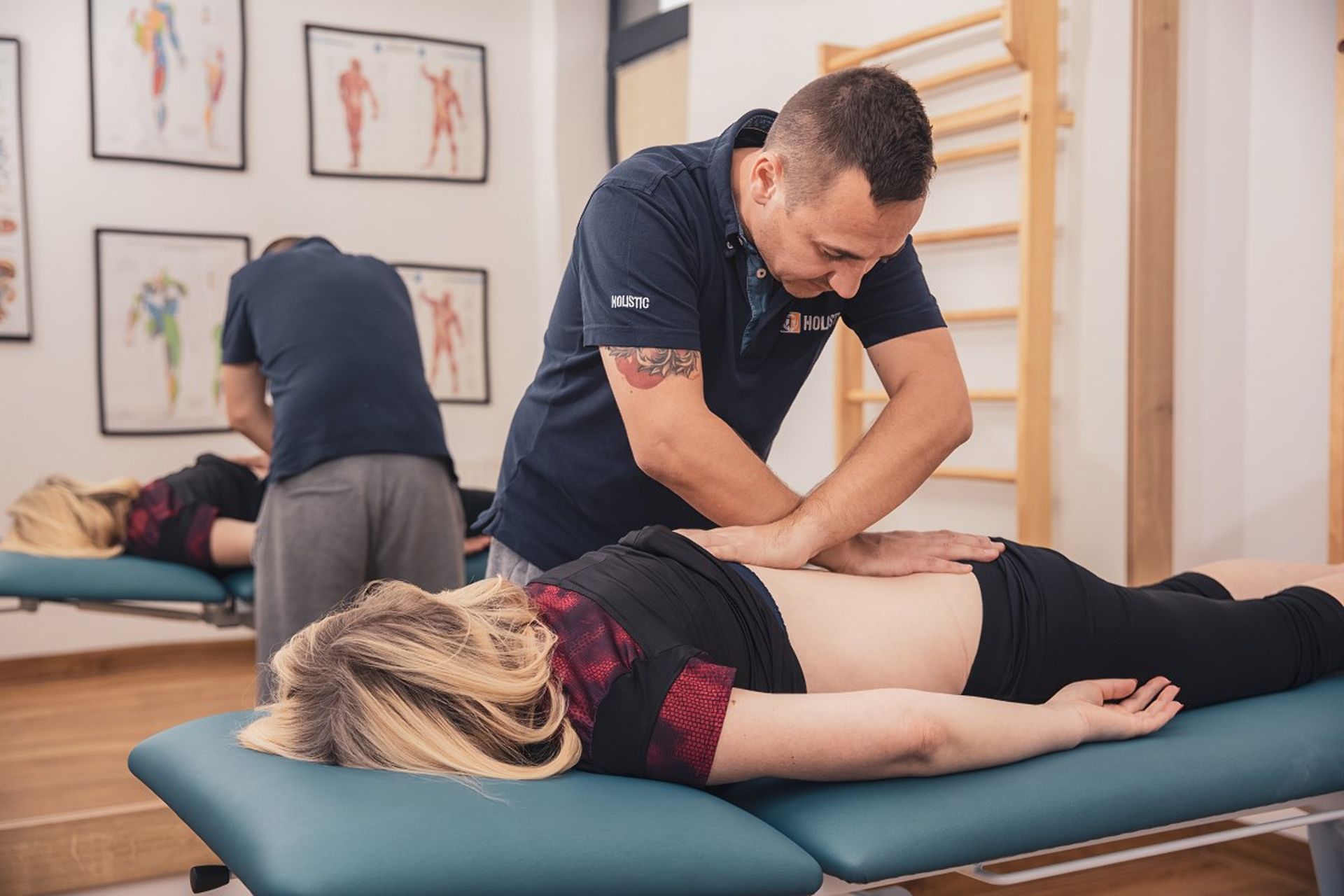
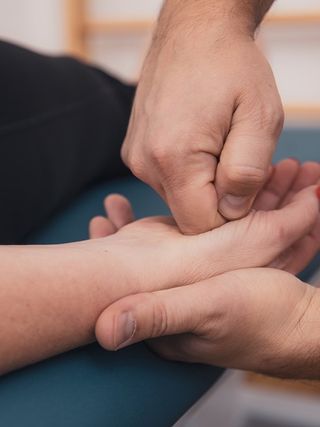
Manipulacja powięzi
Metoda została opracowana przez włoskiego fizjoterapeutę Luigiego Stecco, który przez 40 lat praktyki klinicznej i wnikliwego studiowania anatomii i fizjologii człowieka opracował niezwykle efektywny i spójny system terapeutyczny. Autor zauważył, że pewne miejsca w ciele wykazują dużą bolesność dotykową, jeśli konsystencja tkanek w tym obszarze jest zmieniona, a przywrócenie prawidłowego ślizgu między tymi tkankami (manipulacja) wywołuje reakcje w odległych obszarach ciała. Wiele lat trwało opracowanie mapy tych punktów, które ( i nie ma w tym nic dziwnego) w większości pokrywają się z punktami akupunkturowymi. Punkty te nazwał Centrami Koordynacji (CC) i Centramii Fuzji (CF). Stecco doszedł do wniosku, że te szczególne miejsca leżą na przebiegu linii napięć systemu powięziowego, który jest ,,pasem transmisyjnym” do rozchodzenia się kompensacji mechanicznych oraz promieniowania bólu w naszym ciele. Metoda, uwzględnia więc całościowe podejście do ciała, traktując poszczególne jego segmenty, jako pojedyncze ogniwa łańcucha tkankowego, którego ciągłość zapewnia powięź. Wyboru punktów przeznaczonych do manipulacji dokonuje się według określonych reguł – na podstawie weryfikacji ruchowej i palpacyjnej. Niezwykle istotnym elementem gwarantującym skuteczną terapię jest szczegółowy wywiad. Kolejnym aspektem przemawiającym za wyjątkowością tego konceptu jest jego niezwykła efektywność terapeutyczna, która w ciągu zaledwie kliku wizyt pozwala rozwiązać wiele problemów pacjentów, leczonych klasycznie przez lata.
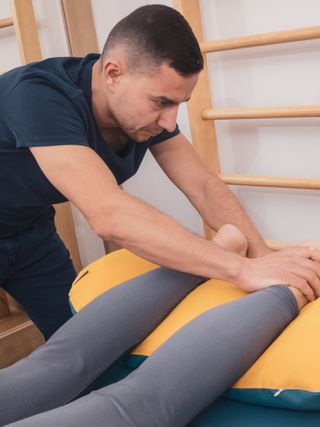
Metoda GDS
Metoda Łańcuchów Mięśniowych została opracowana przez Godelieve Denis-Struyf, belgijską fizjoterapeutkę i osteopatkę. Jest to metoda pracy terapeutycznej będąca podstawą do zindywidualizowanego podejścia do pacjenta. Łączy w sobie rehabilitację, fizjoterapię, dbanie o zdrowie, zapobieganie problemom, nie pomijając aspektu związanego z psychiką i zachowaniem człowieka. Koncept Łańcuchów Mięśniowych pani Godelieve Denys- Struyf jest podejściem do psychiki i ciała i, z tego tytułu, ma różne oblicza. Metoda oferuje sposób obserwacji, pomiary, testy, rygorystyczne analizy i interpretacje oraz szeroki wachlarz narzędzi terapeutycznych. Wszystkie części ciała zależą od siebie wzajemnie a mięśnie i ich otoczki ułożone w łańcuchy, łączą części ciała między sobą. Mięśnie są ponadto narzędziami wyrazu psychiczno-cielesnego: naszego stanu napięć, naszych emocji, uczuć i sposobu bycia, wyrażających się poprzez system mięśniowo-powięziowy, co wywiera wpływ na postawę, oddychanie i gesty. Kiedy napięcia czy zachowania powtarzają się i przedłużają, pojawia się nadmiar napięcia mięśniowego, umiejscawiający się i stopniowo obejmujący coraz bardziej pewne specyficzne obszary, aż do wywołania w ciele prawdziwych pasm napięcia powięziowego. Mechanizm ten determinuje stopniowo serię przemieszczeń stawowych, które określamy mianem ciągu stawowego. Metoda proponuje szeroki zakres technik, pozwalający sprostać konieczności dostosowywania się do sytuacji, której część stanowi terapeuta. Niezależnie od stosowanej techniki metoda ta opiera się zawsze na doskonałej znajomości anatomii i fizjologii.
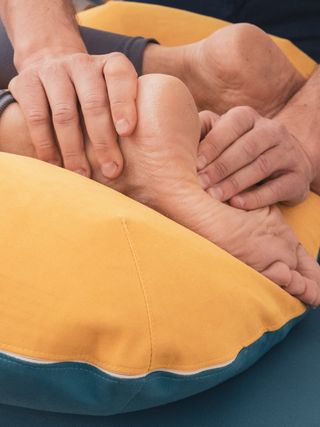
Techniki Terapii Tkanek Miękkich
Techniki Energizacji Mięśni – MET
Jest to zbiór metod mających swoje pochodzenie w ortopedii, fizjoterapii oraz chiropraktyce, wykorzystujących wysiłek pacjenta na różne sposoby w celu likwidowania zaburzeń w obrębie tkanek miękkich. Techniki Energizacji Mięśni można stosować gdy: zaobserwujemy hipertonię mięśniową, przykurcze pochodzenia mięśniowego oraz łącznotkankowego, spastykę, osłabienie fizjologiczne mięśni, obrzęk miejscowy, zastój żylny, ograniczenie ruchomości stawów wynikające z dysfunkcji tkanek miękkich. Techniki te mogą być stosowane zarówno u bardzo chorych pacjentów z ostrymi stanami bólowymi, jak również u osób chorych przewlekle np. w chorobach reumatycznych czy osteoporozie.
Techniki Aktywnego Rozluźniania
Należą do metod medycyny manualnej koncentrujących swoja uwagę na likwidowaniu nieprawidłowości w obrębie tkanki miękkiej takich jak: zrosty i sklejenia, nadmierny tonus mięśniowy, przykurcze mięśniowe i łącznotkankowe. Należą do najefektywniejszych metod w likwidowaniu tych zaburzeń. Są one osiągnięciem ostatnich lat w medycynie manualnej. Często łączone z Technikami Mięśniowo-powięziowego rozluźniania czy też Technikami Energizacji Mięśni są niezwykle efektywne. Technika polega na utrzymaniu stałego nacisku lub zablokowaniu tkanek, podczas gdy jednocześnie wykonywane jest aktywne rozciąganie tkanki. Istnieją trzy typy technik aktywnego rozluźniania: Pasywna: terapeuta utrzymuje nacisk na tkankę i sam porusza częścią ciała, którą ma rozluźnić. Forma ta jest bardzo relaksująca i powoduje duże rozluźnienie. Aktywna: terapeuta wywiera nacisk, a pacjent wykonuje ruch ciała w kierunku rozciągania. Jest ona bardziej intensywna, ale czasami lepiej tolerowana przez pacjenta, szczególnie w bólu (samokontrola ruchu). Można ją połączyć z oporowaniem ruchu lub Technikami Energizacji Mięśni. W pozycji obciążenia stawu: jest bardzo efektywna w przywracaniu pełnej funkcji tkanek np. u sportowców. Wykonuje się często w pracy ekscentrycznej. Powinna być wykonywana na końcu procesu leczenia.
Rozluźnianie Mięśniowo – Powięziowe
Techniki MR są jednymi z najnowszych metod terapeutycznych w medycynie manualnej. Koncentrują się one na pracy z systemem mięśniowo-powięziowym. Techniki te poprawiają wewnętrzną ruchomość tkanek miękkich, szczególnie powięzi. Żywa tkanka posiada wewnętrzną zdolność do poruszania się, będącą rezultatem rytmicznych zmian zachodzących w tonusie mięśni i wewnętrznych rytmach ciała (skurcze naczyń krwionośnych, ruchy jelit, oddychanie, skurcze mięśni, ruchy gałek ocznych itp.). Aktywacja sił w technikach MR odbywa się w sposób bezpośredni i pośredni. Są one zarówno pochodzenia wewnętrznego jak i zewnętrznego. Siły wewnętrzne wiążą się z fizjologicznymi ruchami żywej tkanki wymienionymi wyżej. Siły zewnętrzne związane są z dostarczaniem energii mechanicznej wywieranej przez terapeutę poprzez nacisk, trakcję, skręcanie, rozciąganie, które w odpowiedni sposób wpływają na tkankę miękką, zmieniając jej właściwości biomechaniczne oraz wywołując reakcje odruchowe. Łączy je główny cel medycyny manualnej, jakim jest osiągnięcie symetrycznego, bezbólowego zakresu ruchu systemu mięśniowo-szkieletowego.
Pozycyjne Rozluźnianie
Jest to metoda opracowana w latach 60-tych przez osteopatę Jonesa, który zaobserwował, że ułożenie stawu w pozycji maksymalnego rozluźnienia i utrzymanie tej pozycji przez 20-120 sekund powoduje radykalną poprawę zakresu ruchu stawu oraz zmniejszenie jego dolegliwości bólowych. Jones uważa, że ułożenie stawu w kierunku, gdzie zmniejsza się napięcie mięśniowe powoduje odruchowe rozluźnienie mięśni hipertonicznych w wyniku zmniejszenia stymulacji nocyceptywnej, a poprzez to zmianę aktywności receptorów wrzecionek mięśniowych oraz poprawę ukrwienia ischemicznych i hipertonicznych mięśni. Terapeuta wyszukuje najbardziej wrażliwy punkt i kontrolując go palcem układa ciało pacjenta w pozycji tak, aby punkt ten zniknął lub się zmniejszył do 2 punktów (w subiektywnej skali odczuwania bólu od 0 do 10) i utrzymuje tę pozycję 90 sekund.
Terapia Punktów Spustowych
Terapia punktów spustowych jest techniką, która wykorzystuje różne formy ucisku i ruchów we wrażliwych miejscach w tkance mięśniowej. Celem terapii jest uwolnienie się od bólu i poprawa zaburzonych wzorców ruchowych. Punkty spustowe to wrażliwe miejsca w mięśniach o wzmożonym napięciu, które są bolesne pod wpływem ucisku i powodują ból promieniujący oraz inne objawy w obszarach ciała odległych od miejsca drażnienia.
Masaż Tkanek Głębokich
Jest formą terapii skupiającą się na przywracaniu prawidłowego napięcia głębokich warstw mięśni i tkanki łącznej. Poprzez rozluźnienie, wydłużenie, zlikwidowanie zrostów i uwolnienie utrzymujących się wzorców nieprawidłowych napięć w układach tkanek – powoduje zmniejszenie bólu, poprawę giętkości i płynności ruchu oraz przywraca prawidłowy zakres w najbardziej efektywny i najmniej obciążający sposób.
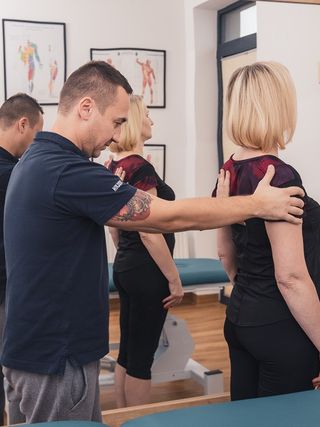
Autoterapia
Podczas badania fizjoterapeutycznego oceniony zostaje indywidualny problem pacjenta. Nad konkretnymi elementami związanymi z tym problemem pracują później nasi terapeuci. Ale co zrobić, żeby efekty terapii trwały bardzo długo? Jak wzmocnić rezultaty terapii? I wreszcie jak zapobiegać nawracaniu problemów? Odpowiedzią na wszystkie powyższe pytania jest autoterapia. Autoterapia to indywidualnie dostosowane ćwiczenia łatwe do wykonania w warunkach domowych i opierające się głównie o metodę poizometrycznej relaksacji mięśni (PIR), ale także różnego rodzaju pozycje rozciągające poszczególne mięśnie lub całe taśmy anatomiczne. Autoterapia wraz z edukacją posturalną stanowi ważny czynnik uzupełniający proces leczenia i zapewniający jego długotrwałe rezultaty. Dlatego sukces terapeutyczny zależy również w pewnym stopniu od poziomu motywacji pacjenta.
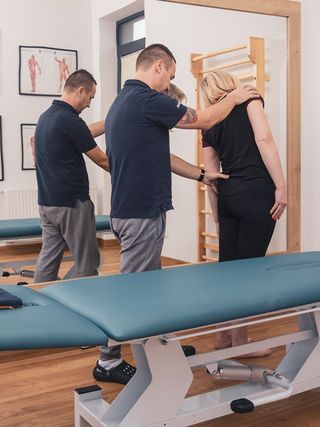
Metoda PNF
Metoda PNF jest koncepcja posiadającą własną filozofię i zasady pracy z pacjentem. Opierając się na budowie anatomicznej człowieka proponuje ruchy naturalne, przebiegające trójpłaszczyznowo, zbliżone do aktywności dnia codziennego. Podstawowym celem terapii jest praca nad funkcją, której pacjent potrzebuje. Koncepcja ta zaleca postrzeganie chorego w sposób całościowy, wykorzystując do terapii silne i zdrowe regiony ciała. Celem terapii jest przywrócenie wzorców ruchowych, takich jak prawidłowe chodzenie i siadanie, wykorzystując techniki stabilizujące, rozluźniające, przeciwbólowe oraz uczące ruchu i koordynacji. Istotą metody PNF jest maksymalne pobudzenie ekstero i proprioreceptorów znajdujących się w ciele oraz różnych sfer kory mózgowej w celu ułatwienia (torowania) ruchu w obszarze uszkodzonym. Siła mięśni, zakres ruchu – to, co jest ważne w tradycyjnym postępowaniu terapeutycznym, jest tylko środkiem do uzyskania celu jakim jest funkcja. Koncepcja ta zaleca postrzeganie chorego w sposób całościowy, wykorzystując do terapii silne i zdrowe regiony ciała. Umożliwia to pełne wykorzystanie rezerw tkwiących w organizmie, motywuje do dalszego działania, a co najważniejsze zapewnia bezbolesną pracę, bez traumatyzujących psychicznie i fizycznie doznań. Chory powinien być partnerem fizjoterapeuty, określającym zakres i granice działania. To on ustala cele terapii. Terapeuta ma w tym wypadku rolę doradczą. Dzięki takiemu podejściu chory nawet z dużą dysfunkcją zachowuje dobrą motywację i jest pozytywnie nastawiony do współpracy z terapeutą.
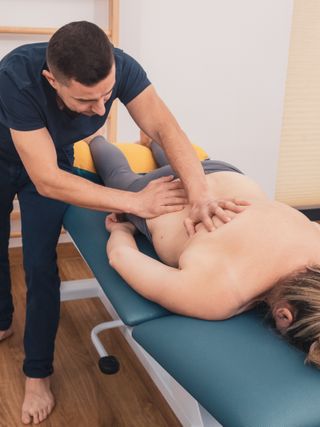
Terapia Manualna (OMT)
Zajmuje się: diagnozowaniem i leczeniem zaburzeń strukturalnych narządu ruchu (stawów, mięśni, nerwów). Dzięki rozbudowanemu schematowi badania różnicującego, fizjoterapeuta jest w stanie za pomocą szczegółowego wywiadu i badania odnaleźć zaburzone struktury, stwierdzić stopień ich uszkodzenia oraz przeanalizować mechanizmy pojawienia się dolegliwości. Tym samym stawia hipotezę zaburzenia strukturalnego u pacjenta. Przyczyna dolegliwości leży często w dysproporcji pomiędzy możliwościami tkanki do przyjmowania obciążenia, a jej rzeczywistym obciążaniem. Leczenie polega na zniesieniu tej dysproporcji i przywracaniu fizjologicznej „symbiozy” pomiędzy stawami, mięśniami i strukturami nerwowymi. Jako leczenie stosowane są techniki: mobilizacji stawów, neuromobilizacje struktur nerwowych, leczenie tkanek miękkich (tj. mięśni, więzadeł, ścięgien), a także medyczny trening funkcjonalny z użyciem urządzeń treningowych dostosowanych do problemów pacjentów.
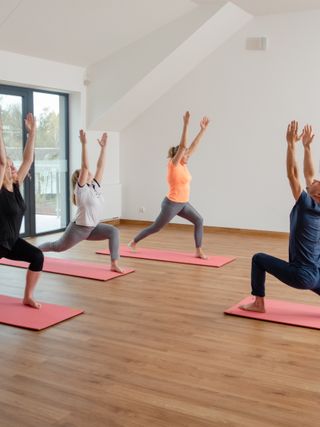
Trening Sensomotoryczny
Trening Sensomotoryczny nakierowany jest na łączne usprawnianie systemów ekstero oraz proprioreceptorów z układem motorycznym oraz stymulację ich prawidłowej integracji w ośrodkowym układzie nerwowym. W terapii wykorzystuje się różne przybory sensomotoryczne tj: piłki, trenery, taśmy.
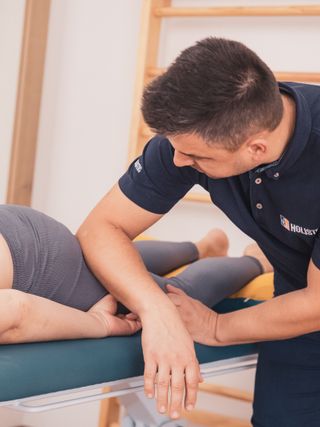
Metoda McKenziego
Celem nadrzędnym metody McKenzie jest przywrócenie możliwe pełnej funkcji zaburzonym strukturom, a tym samym zabezpieczenie pacjenta przed kolejnym pojawieniem się problemu bólowego. Po przeprowadzeniu odpowiedniej edukacji pacjenta, metoda ta pozwala samodzielnie radzić sobie z bólem. Autor metody opracował program postępowania leczniczego, w którym oprócz technik, wykonywanych przez terapeutę, ważny jest sam ruch pacjenta, ćwiczenia i autoterapia wykonywana w domu. W ćwiczeniach dominują pozycje niskie, głównie leżące. Ruchy czynne powtarzane są wielokrotnie w różnych płaszczyznach, ale w ściśle określonym kierunku, niepowodującym bólu. Dużą wagę przykłada się do zaleceń, które chronią kręgosłup przed kolejnymi urazami i przeciążeniami. McKenzie stawia bardzo duży nacisk na profilaktykę.
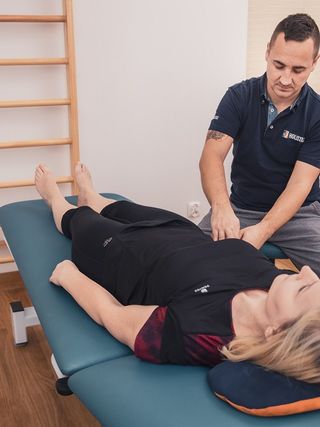
Kinesiology Taping
Kinesiology Taping to metoda, która pozwala na osiąganie doskonałych rezultatów terapeutycznych przez działanie sensoryczne specjalnego plastra. Celem tej terapii jest wykorzystanie naturalnych procesów samoleczenia organizmu, których punktem wyjścia są skóra i mięśnie. Kinesiology taping poprzez odpowiednią aplikację plastra zmniejsza patologiczne napięcie mięśni, ułatwia ich funkcję, poprawia mikrokrążenie, aktywuje system limfatyczny oraz wspiera funkcję stawów. Działa zgodnie z funkcjonowaniem organizmu przez 24 godziny na dobę, a nie tylko podczas sesji terapeutycznej.
Trzy etapy strategii leczenia
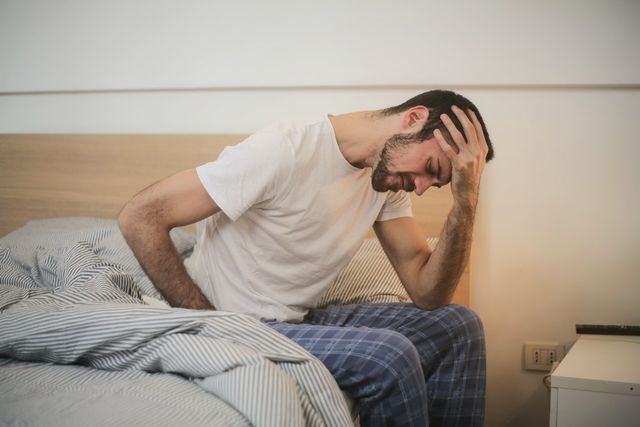
Etap I
Na tym etapie stosujemy techniki na tkanki bezpośrednio zaangażowane w wywołanie problemu z którym pacjent zgłosił się do gabinetu.
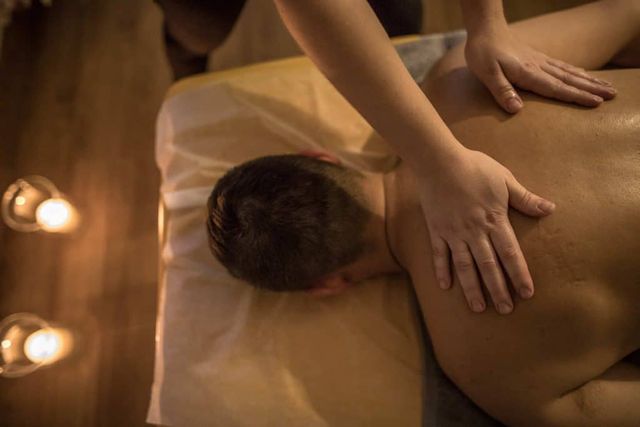
Etap II
Kolejny etap leczenia rozpoczyna się wraz z wyeliminowaniem dolegliwości bólowych bądź zmniejszeniem ich do takiego stopnia, który umożliwia przywrócenie sprawności. Jest to stosowny moment, aby zająć się pierwotną przyczyną, będącą źródłem wcześniejszych objawów i dolegliwości – w ten sposób zapobiegamy nawrotowi dysfunkcji. Etap ten, będący wyrazem holistycznego spojrzenia na Pacjenta, pozwala ustrzec Go przed kolejnymi incydentami bólowymi.
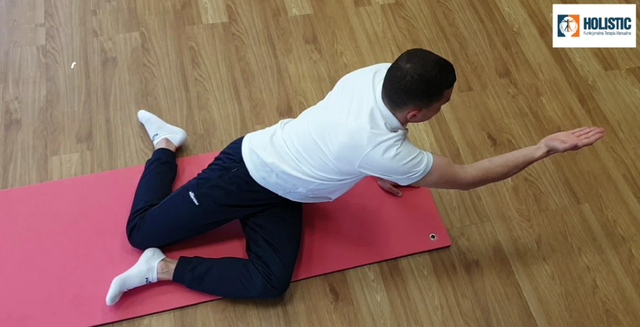
Etap III
Na tym etapie analizujemy ruch, postawę, nawyki, stereotypy ruchowe Pacjenta. Wdrażamy procedury zmierzające do przeprogramowania nieodpowiednich wzorców ruchowych, leżących u podstaw dolegliwości Pacjenta.
Fizjoterapeuta ocenia możliwości motoryczne pacjenta i w zależności od stopnia jego sprawności, dobiera odpowiednie ćwiczenia do wykonywania w domu. Jest to bardzo ważny etap, a jego skuteczność zależy od stopnia zaangażowania pacjenta. Należy nadmienić, iż od pierwszej wizyty pacjent rozpoczyna samodzielne wykonywanie w domu odpowiednio dobranych ćwiczeń. Do osiągnięcia celów leczenia niezbędnych jest na ogół od 3 do 7 terapii. Trójetapowy model terapii gwarantuje, że Pacjent będzie mógł cieszyć się pełnią sił i sprawnością jak najdłużej. Kompleksowe podejście do problemu przekłada się na jego trwałe rozwiązanie.
Potrzebujesz pomocy lub porady?
Recepcja
Centrum Terapii
Restauracja

